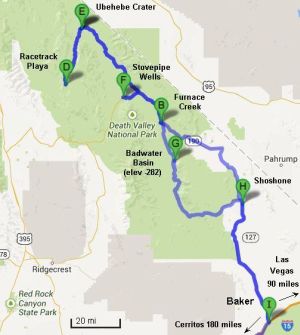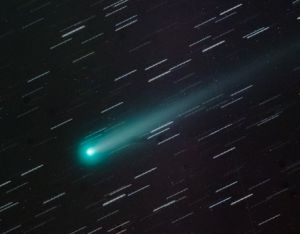
 Travel
[1404.07]
Travel
[1404.07]
All year long we had planned to visit Death Valley in winter, to attempt to get a good view of Comet ISON (about which more below). Unlike the comet, Death Valley did not disappoint!
 At almost 3.4 million acres, Death Valley is the largest national park in the
lower 49 states (excluding Alaska). It is more than 10 times the size of
Hawaii Volcanoes National Park and 100 times the size of Haleakala National
Park. The map at left shows most of the park, which gerrymanders around mining
operations along highways 127 and 190.
At almost 3.4 million acres, Death Valley is the largest national park in the
lower 49 states (excluding Alaska). It is more than 10 times the size of
Hawaii Volcanoes National Park and 100 times the size of Haleakala National
Park. The map at left shows most of the park, which gerrymanders around mining
operations along highways 127 and 190.
Death Valley National Park is famous for its extremes. It is home to Furnace Creek, where the highest temperature in the world was recorded (134° in 1913), as well as Badwater Basin, the driest spot in North America and, at 282 feet below sea level, the lowest spot in the Western Hemisphere (not counting one spot in Argentina).
We were less aware of its huge range in elevation (up to 11,000’) and how
spectacular and varied its scenery is. We thought we had allocated plenty of
time to make the almost 300-mile drive to Furnace Creek, but well before
reaching the park boundary we were already stopping every few miles to take
photos!
As a result, we cooked in the dark at our campsite in Texas Springs (40’ below sea level). Sleeping inside our Honda Element, the first night it was a balmy 49°, so we were pretty cozy despite the strong winds rocking us all night long. Then we realized it was rain, not sand, pelting us, so we scrambled to secure our supplies outside. Luckily the shower was very light, in contrast to a deluge that occurred a week before Thanksgiving, dropping 1.8” of rain in two days (ten times the average for the whole month of November).
After camping at Mesquite Spring (elev 1800’, with a cold front sending temperatures to the low 30’s), we set off for nearby Ubehebe Crater to commence a 2˝ hour drive on 27 miles of very rough dirt road to get to Racetrack Playa, known for its moving rocks.
On this road we found out a few things the hard way . First, to cross over to the other side of the Panamint Range, the dirt road climbs up to almost 5000’ elevation. This was actually pretty neat, as it took us through some huge stands of Joshua trees, which only grow at higher altitudes. We hit a few stretches of snow and mud, and a few spots where more axle clearance would have been nice, but fortunately were able to skirt around them without incident.
The biggest surprise was the playa itself. As we approached it, we thought "wow, that mirage in the distance really looks like a lake." As we got closer, we realized it WAS a lake, and frozen over to boot! It turned out November's deluge had completely flooded the playa.
Much is made about the so-called "mystery" rocks of the Racetrack, but as we walked around, there was absolutely no question in our minds how they move. The silt is so fine that when it gets wet it is a very effective lubricant!
By amazing luck, we were able to talk to a ranger on his way out with a crew of clean up volunteers. In his 23 years at Death Valley, he had never before seen the playa so submerged. He also saved us the trouble of trying to find the most famous rock tracks, which are quite a ways from the road; they had already searched but could find no trace of them in the shallow lake.
Although we missed the Racetrack rocks, Death Valley was still a great
adventure, and we were able to see
many stunning
sights in and around the park. It truly is a geologist’s dream!
RIP Comet ISON
 When Comet ISON was discovered in late 2012, there were hopes it would put
on a spectacular display. Not only did it appear to be very bright for an
object so far away, it would also pass extremely close to the sun, possibly
producing a long, bright tail. The fact that it would do its “sungrazing” on
Thanksgiving Day was what made us select Death Valley—we had always wanted
to go in fall or winter, so the timing seemed perfect.
When Comet ISON was discovered in late 2012, there were hopes it would put
on a spectacular display. Not only did it appear to be very bright for an
object so far away, it would also pass extremely close to the sun, possibly
producing a long, bright tail. The fact that it would do its “sungrazing” on
Thanksgiving Day was what made us select Death Valley—we had always wanted
to go in fall or winter, so the timing seemed perfect.
Unfortunately, Comet ISON could not live up to the hype. Though Dave did get some astrophotos in November, the comet did not become bright enough nor the tail long enough to make for great viewing. So instead of going out to Death Valley a week before Thanksgiving, we decided to go out the first week of December, to try to catch the comet after it finished passing around the sun.
Comet ISON never made it. But, in the end it gave us two gifts. First, we
finally made it to Death Valley. Second, we postponed the trip long enough
to miss the November deluge! Thanks, ISON!